ESP Alfa Romeo 166 2007 Owner handbook (in English)
[x] Cancel search | Manufacturer: ALFA ROMEO, Model Year: 2007, Model line: 166, Model: Alfa Romeo 166 2007Pages: 272, PDF Size: 4.17 MB
Page 112 of 272
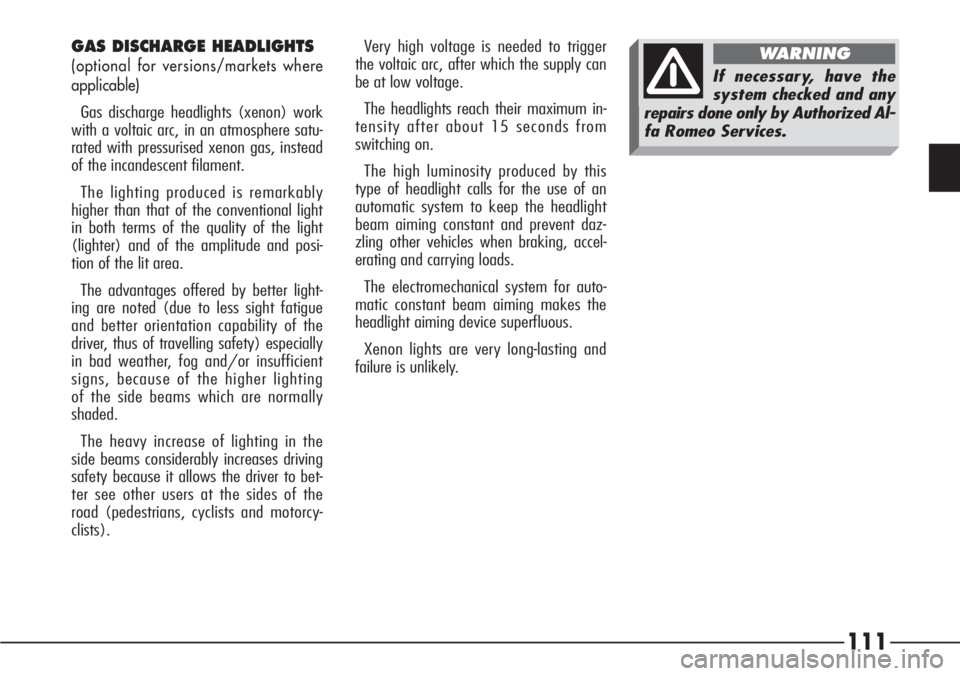
111
GAS DISCHARGE HEADLIGHTS
(optional for versions/markets where
applicable)
Gas discharge headlights (xenon) work
with a voltaic arc, in an atmosphere satu-
rated with pressurised xenon gas, instead
of the incandescent filament.
The lighting produced is remarkably
higher than that of the conventional light
in both terms of the quality of the light
(lighter) and of the amplitude and posi-
tion of the lit area.
The advantages offered by better light-
ing are noted (due to less sight fatigue
and better orientation capability of the
driver, thus of travelling safety) especially
in bad weather, fog and/or insufficient
signs, because of the higher lighting
of the side beams which are normally
shaded.
The heavy increase of lighting in the
side beams considerably increases driving
safety because it allows the driver to bet-
ter see other users at the sides of the
road (pedestrians, cyclists and motorcy-
clists).Very high voltage is needed to trigger
the voltaic arc, after which the supply can
be at low voltage.
The headlights reach their maximum in-
tensity after about 15 seconds from
switching on.
The high luminosity produced by this
type of headlight calls for the use of an
automatic system to keep the headlight
beam aiming constant and prevent daz-
zling other vehicles when braking, accel-
erating and carrying loads.
The electromechanical system for auto-
matic constant beam aiming makes the
headlight aiming device superfluous.
Xenon lights are very long-lasting and
failure is unlikely.
If necessary, have the
system checked and any
repairs done only by Authorized Al-
fa Romeo Services.
WARNING
Page 118 of 272
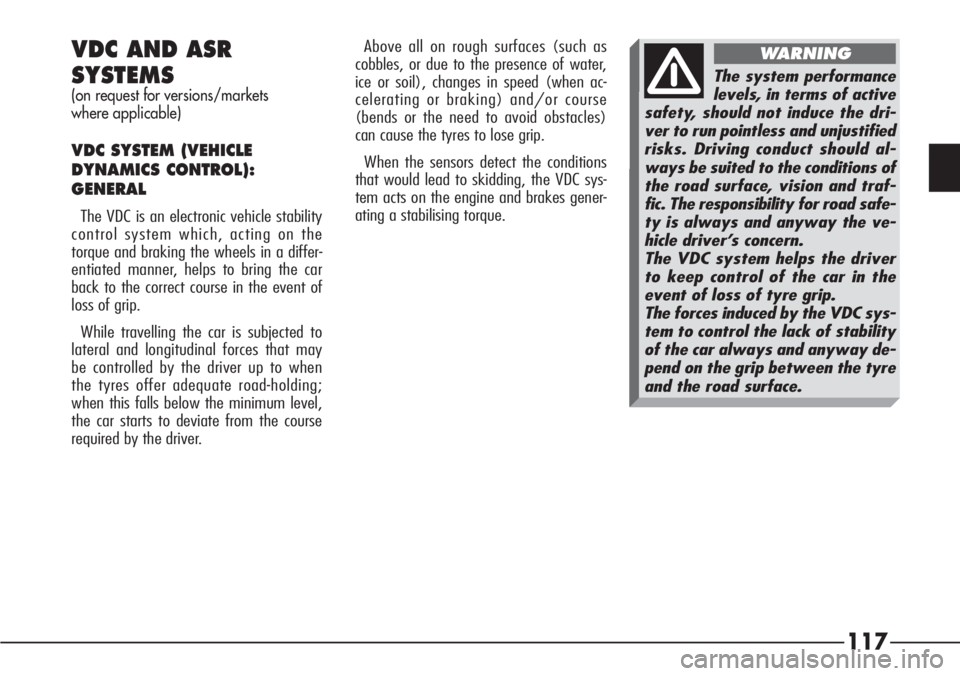
117
VDC AND ASR
SYSTEMS
(on request for versions/markets
where applicable)
VDC SYSTEM (VEHICLE
DYNAMICS CONTROL):
GENERAL
The VDC is an electronic vehicle stability
control system which, acting on the
torque and braking the wheels in a differ-
entiated manner, helps to bring the car
back to the correct course in the event of
loss of grip.
While travelling the car is subjected to
lateral and longitudinal forces that may
be controlled by the driver up to when
the tyres offer adequate road-holding;
when this falls below the minimum level,
the car starts to deviate from the course
required by the driver.Above all on rough surfaces (such as
cobbles, or due to the presence of water,
ice or soil), changes in speed (when ac-
celerating or braking) and/or course
(bends or the need to avoid obstacles)
can cause the tyres to lose grip.
When the sensors detect the conditions
that would lead to skidding, the VDC sys-
tem acts on the engine and brakes gener-
ating a stabilising torque.
The system performance
levels, in terms of active
safety, should not induce the dri-
ver to run pointless and unjustified
risks. Driving conduct should al-
ways be suited to the conditions of
the road surface, vision and traf-
fic. The responsibility for road safe-
ty is always and anyway the ve-
hicle driver’s concern.
The VDC system helps the driver
to keep control of the car in the
event of loss of tyre grip.
The forces induced by the VDC sys-
tem to control the lack of stability
of the car always and anyway de-
pend on the grip between the tyre
and the road surface.
WARNING
Page 119 of 272
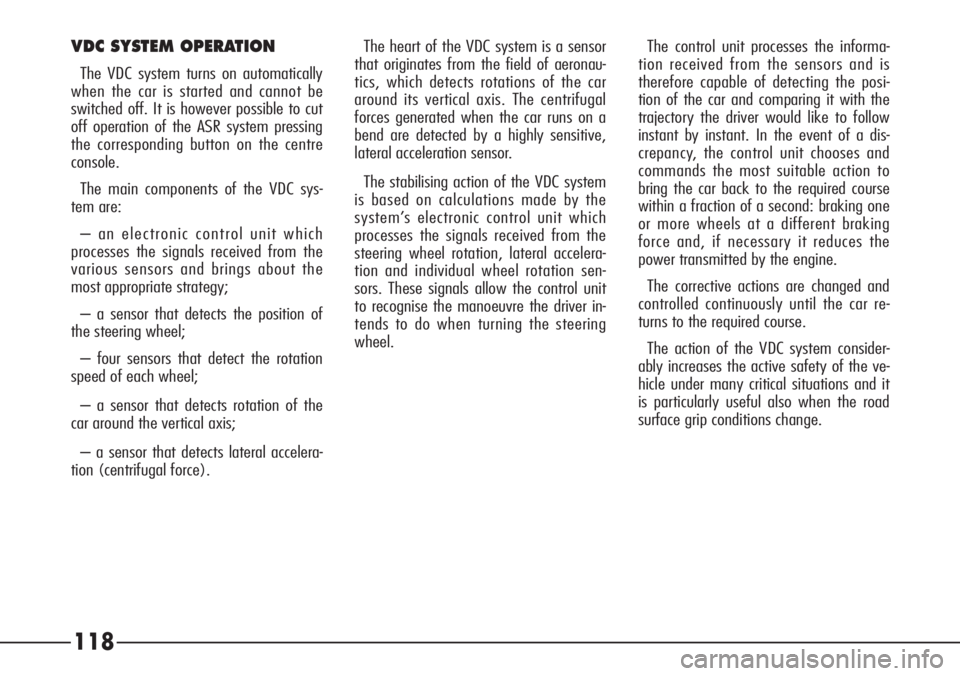
The heart of the VDC system is a sensor
that originates from the field of aeronau-
tics, which detects rotations of the car
around its vertical axis. The centrifugal
forces generated when the car runs on a
bend are detected by a highly sensitive,
lateral acceleration sensor.
The stabilising action of the VDC system
is based on calculations made by the
system’s electronic control unit which
processes the signals received from the
steering wheel rotation, lateral accelera-
tion and individual wheel rotation sen-
sors. These signals allow the control unit
to recognise the manoeuvre the driver in-
tends to do when turning the steering
wheel.
118
VDC SYSTEM OPERATION
The VDC system turns on automatically
when the car is started and cannot be
switched off. It is however possible to cut
off operation of the ASR system pressing
the corresponding button on the centre
console.
The main components of the VDC sys-
tem are:
– an electronic control unit which
processes the signals received from the
various sensors and brings about the
most appropriate strategy;
– a sensor that detects the position of
the steering wheel;
– four sensors that detect the rotation
speed of each wheel;
– a sensor that detects rotation of the
car around the vertical axis;
– a sensor that detects lateral accelera-
tion (centrifugal force).The control unit processes the informa-
tion received from the sensors and is
therefore capable of detecting the posi-
tion of the car and comparing it with the
trajectory the driver would like to follow
instant by instant. In the event of a dis-
crepancy, the control unit chooses and
commands the most suitable action to
bring the car back to the required course
within a fraction of a second: braking one
or more wheels at a different braking
force and, if necessary it reduces the
power transmitted by the engine.
The corrective actions are changed and
controlled continuously until the car re-
turns to the required course.
The action of the VDC system consider-
ably increases the active safety of the ve-
hicle under many critical situations and it
is particularly useful also when the road
surface grip conditions change.
Page 130 of 272

129
ENVIRONMENTAL
PROTECTION
The design and construction of the vehi-
cle have not only been developed with
the traditional aspects of performance
and safety in mind but also take into ac-
count the increasingly pressing problems
tied to protecting the environment.
The choice of materials, techniques and
particular devices are the result of work
which has made it possible to drastically
reduce the harmful effects on the environ-
ment and guarantee respect for the sever-
est international norms.
USE OF NON-TOXIC
MATERIALS
None of the components of the vehicle
contain asbestos. The padding and the cli-
mate control system do not contain CFCs
which are held to be responsible for the
destruction of the ozone layer.
The colouring agents and the corrosion
inhibitors used on the nuts, screws and
bolts do not contain cadmium or chrome
which could pollute the atmosphere or
water tables.
EMISSION REDUCING DEVICES
(Petrol engines)
Catalysts
The exhaust system is fitted with a sys-
tem of catalysts formed of precious metal
alloys housed in a stainless steel contain-
er which withstand high operating tem-
peratures.
The catalysts convert unburned hydro-
carbons, carbon monoxide and nitric ox-
ides in the exhaust gas (even in minimal
quantity, thanks to the electronic ignition
and injection systems) into non polluting
compounds.
Page 135 of 272

134
In addition to the notes
and specifications given
below we recommend
that, during the initial period, y-
ou do not drive to full vehicle
performance (for example exces-
sive acceleration, long journeys
at top speed, hard braking etc.).
STARTING
THE ENGINE
IMPORTANT The car is fitted with an
electronic engine lock device. if the en-
gine fails to start see “The Alfa Romeo
CODE system”.The ignition switch is fitted with a safety
device which obliges the driver to return
the ignition key to the STOPposition be-
fore repeating the starting operation if
the engine does not start immediately.
Similarly, when the engine is running,
the device prevents the key being moved
fromMARto the AVV position.
PROCEDURE FOR PETROL
ENGINES
With cold engine:
1) Engage the handbrake.
2) Ensure that the systems and electri-
cal devices, especially if they absorb high
quantities of energy (e.g. heated rear
windscreen), are switched off.
3) Set the gearshift lever to neutral and
fully depress the clutch without pressing
the accelerator.
4) Turn the ignition key to the AVV posi-
tion releasing it as soon as the engine starts.
Never leave the ignition
key in the MAR position
when the engine is
switched off.
5) If the engine does not start immedi-
ately, return the key to the STOPposi-
tion and repeat the operation
With hot engine:
1) Engage the handbrake.
2) Ensure that the systems and electri-
cal devices, especially if they absorb high
quantities of energy (e.g. heated rear
windscreen), are switched off.
3) Set the gearshift lever to neutral and
fully depress the clutch without pressing
the accelerator.
4) Turn the ignition key to the AVV posi-
tion releasing it as soon as the engine starts.
5) If the engine does not start immedi-
ately, return the key to the STOPposition
and repeat the procedure, slightly pressing
the accelerator pedal without pumping it.
Running the engine in
confined areas is ex-
tremely dangerous. The engine
consumes oxygen and produces
carbon monoxide which is a highly
toxic and lethal gas.
WARNING
Page 137 of 272
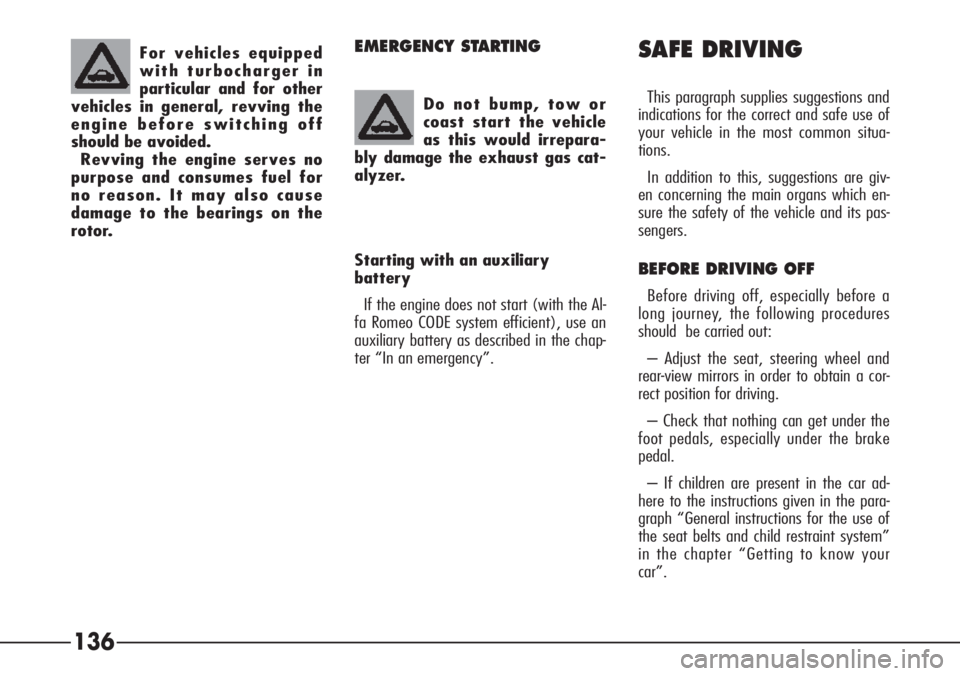
136
EMERGENCY STARTING
Starting with an auxiliary
battery
If the engine does not start (with the Al-
fa Romeo CODE system efficient), use an
auxiliary battery as described in the chap-
ter “In an emergency”.
SAFE DRIVING
This paragraph supplies suggestions and
indications for the correct and safe use of
your vehicle in the most common situa-
tions.
In addition to this, suggestions are giv-
en concerning the main organs which en-
sure the safety of the vehicle and its pas-
sengers.
BEFORE DRIVING OFF
Before driving off, especially before a
long journey, the following procedures
should be carried out:
– Adjust the seat, steering wheel and
rear-view mirrors in order to obtain a cor-
rect position for driving.
– Check that nothing can get under the
foot pedals, especially under the brake
pedal.
– If children are present in the car ad-
here to the instructions given in the para-
graph “General instructions for the use of
the seat belts and child restraint system”
in the chapter “Getting to know your
car”. For vehicles equipped
with turbocharger in
particular and for other
vehicles in general, revving the
engine before switching off
should be avoided.
Revving the engine serves no
purpose and consumes fuel for
no reason. It may also cause
damage to the bearings on the
rotor.
Do not bump, tow or
coast start the vehicle
as this would irrepara-
bly damage the exhaust gas cat-
alyzer.
Page 138 of 272
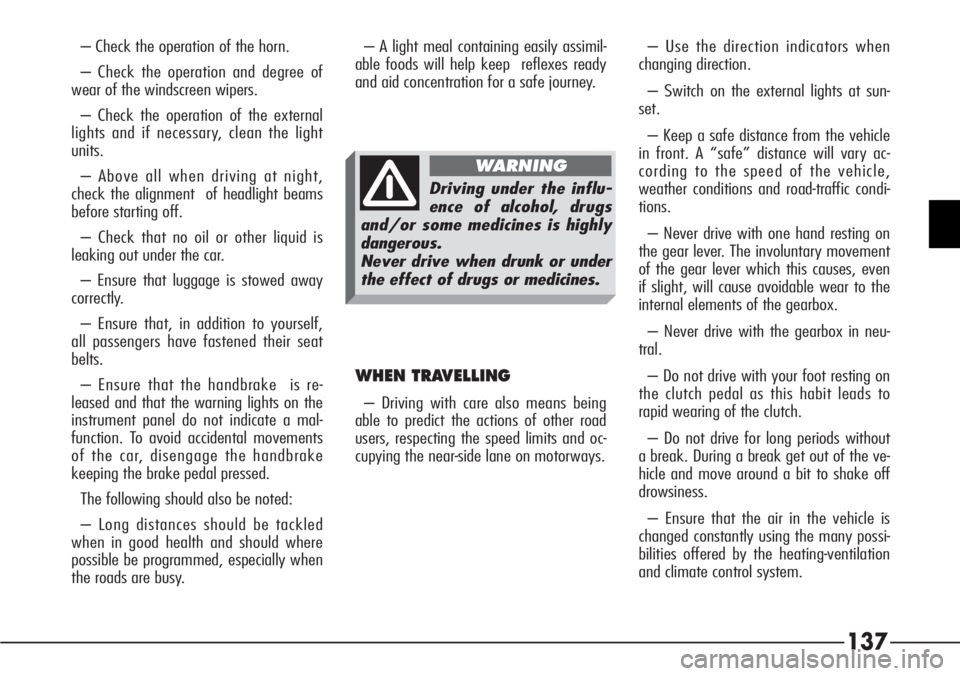
137
– Check the operation of the horn.
– Check the operation and degree of
wear of the windscreen wipers.
– Check the operation of the external
lights and if necessary, clean the light
units.
– Above all when driving at night,
check the alignment of headlight beams
before starting off.
– Check that no oil or other liquid is
leaking out under the car.
– Ensure that luggage is stowed away
correctly.
– Ensure that, in addition to yourself,
all passengers have fastened their seat
belts.
– Ensure that the handbrake is re-
leased and that the warning lights on the
instrument panel do not indicate a mal-
function. To avoid accidental movements
of the car, disengage the handbrake
keeping the brake pedal pressed.
The following should also be noted:
– Long distances should be tackled
when in good health and should where
possible be programmed, especially when
the roads are busy.– A light meal containing easily assimil-
able foods will help keep reflexes ready
and aid concentration for a safe journey.– Use the direction indicators when
changing direction.
– Switch on the external lights at sun-
set.
– Keep a safe distance from the vehicle
in front. A “safe” distance will vary ac-
cording to the speed of the vehicle,
weather conditions and road-traffic condi-
tions.
– Never drive with one hand resting on
the gear lever. The involuntary movement
of the gear lever which this causes, even
if slight, will cause avoidable wear to the
internal elements of the gearbox.
– Never drive with the gearbox in neu-
tral.
– Do not drive with your foot resting on
the clutch pedal as this habit leads to
rapid wearing of the clutch.
– Do not drive for long periods without
a break. During a break get out of the ve-
hicle and move around a bit to shake off
drowsiness.
– Ensure that the air in the vehicle is
changed constantly using the many possi-
bilities offered by the heating-ventilation
and climate control system.
WHEN TRAVELLING
– Driving with care also means being
able to predict the actions of other road
users, respecting the speed limits and oc-
cupying the near-side lane on motorways.
Driving under the influ-
ence of alcohol, drugs
and/or some medicines is highly
dangerous.
Never drive when drunk or under
the effect of drugs or medicines.
WARNING
Page 139 of 272
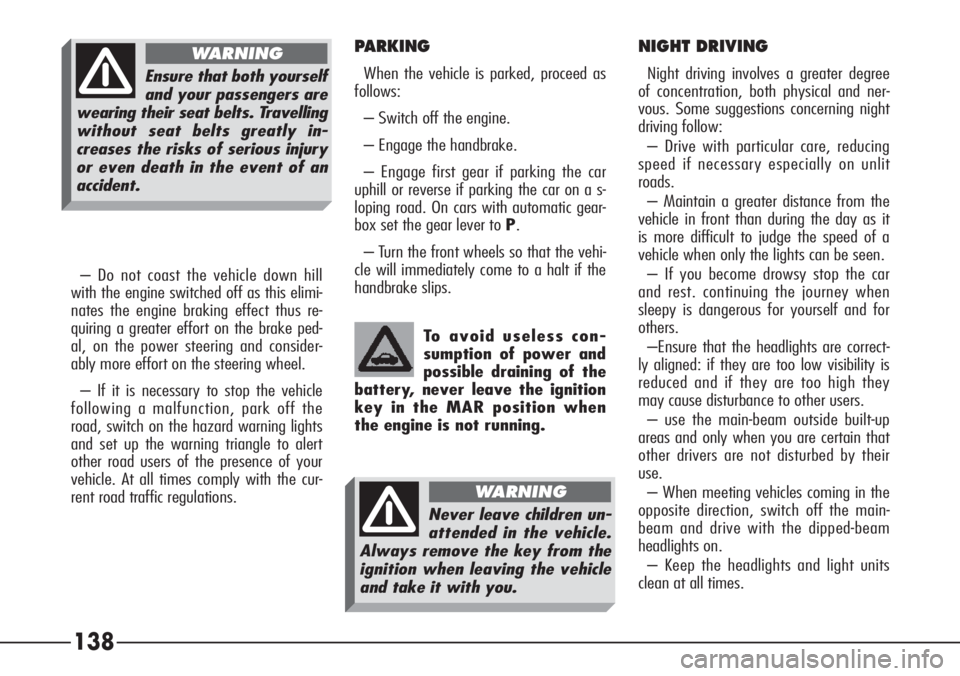
138
PARKING
When the vehicle is parked, proceed as
follows:
– Switch off the engine.
– Engage the handbrake.
– Engage first gear if parking the car
uphill or reverse if parking the car on a s-
loping road. On cars with automatic gear-
box set the gear lever to P.
– Turn the front wheels so that the vehi-
cle will immediately come to a halt if the
handbrake slips.
NIGHT DRIVING
Night driving involves a greater degree
of concentration, both physical and ner-
vous. Some suggestions concerning night
driving follow:
– Drive with particular care, reducing
speed if necessary especially on unlit
roads.
– Maintain a greater distance from the
vehicle in front than during the day as it
is more difficult to judge the speed of a
vehicle when only the lights can be seen.
– If you become drowsy stop the car
and rest. continuing the journey when
sleepy is dangerous for yourself and for
others.
–Ensure that the headlights are correct-
ly aligned: if they are too low visibility is
reduced and if they are too high they
may cause disturbance to other users.
– use the main-beam outside built-up
areas and only when you are certain that
other drivers are not disturbed by their
use.
– When meeting vehicles coming in the
opposite direction, switch off the main-
beam and drive with the dipped-beam
headlights on.
– Keep the headlights and light units
clean at all times. – Do not coast the vehicle down hill
with the engine switched off as this elimi-
nates the engine braking effect thus re-
quiring a greater effort on the brake ped-
al, on the power steering and consider-
ably more effort on the steering wheel.
– If it is necessary to stop the vehicle
following a malfunction, park off the
road, switch on the hazard warning lights
and set up the warning triangle to alert
other road users of the presence of your
vehicle. At all times comply with the cur-
rent road traffic regulations.To avoid useless con-
sumption of power and
possible draining of the
battery, never leave the ignition
key in the MAR position when
the engine is not running.Ensure that both yourself
and your passengers are
wearing their seat belts. Travelling
without seat belts greatly in-
creases the risks of serious injury
or even death in the event of an
accident.
WARNING
Never leave children un-
attended in the vehicle.
Always remove the key from the
ignition when leaving the vehicle
and take it with you.
WARNING
Page 140 of 272
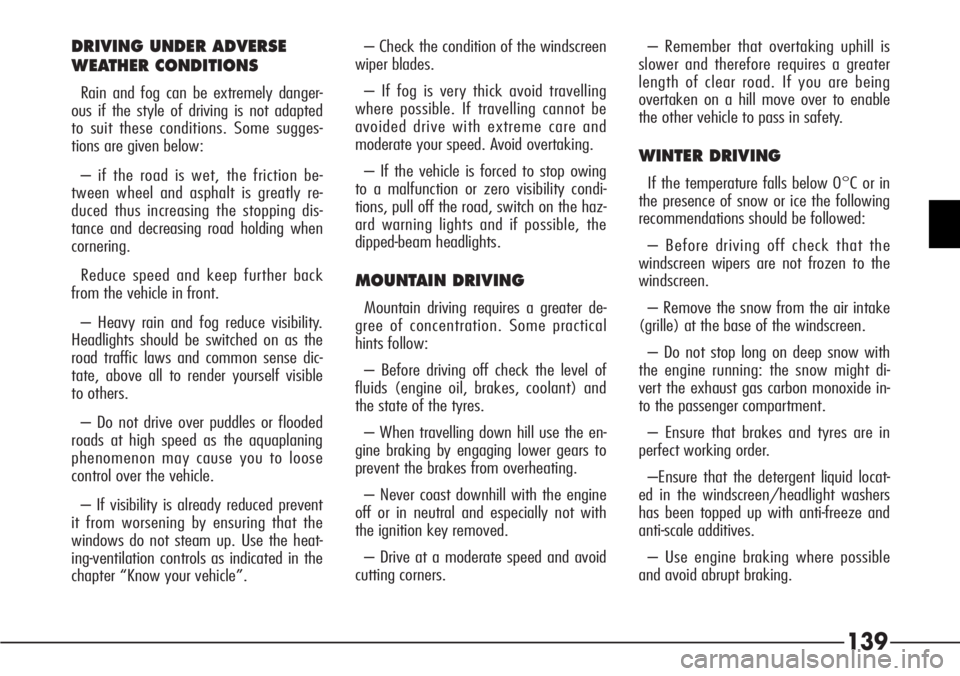
139
DRIVING UNDER ADVERSE
WEATHER CONDITIONS
Rain and fog can be extremely danger-
ous if the style of driving is not adapted
to suit these conditions. Some sugges-
tions are given below:
– if the road is wet, the friction be-
tween wheel and asphalt is greatly re-
duced thus increasing the stopping dis-
tance and decreasing road holding when
cornering.
Reduce speed and keep further back
from the vehicle in front.
– Heavy rain and fog reduce visibility.
Headlights should be switched on as the
road traffic laws and common sense dic-
tate, above all to render yourself visible
to others.
– Do not drive over puddles or flooded
roads at high speed as the aquaplaning
phenomenon may cause you to loose
control over the vehicle.
– If visibility is already reduced prevent
it from worsening by ensuring that the
windows do not steam up. Use the heat-
ing-ventilation controls as indicated in the
chapter “Know your vehicle”.– Check the condition of the windscreen
wiper blades.
– If fog is very thick avoid travelling
where possible. If travelling cannot be
avoided drive with extreme care and
moderate your speed. Avoid overtaking.
– If the vehicle is forced to stop owing
to a malfunction or zero visibility condi-
tions, pull off the road, switch on the haz-
ard warning lights and if possible, the
dipped-beam headlights.
MOUNTAIN DRIVING
Mountain driving requires a greater de-
gree of concentration. Some practical
hints follow:
– Before driving off check the level of
fluids (engine oil, brakes, coolant) and
the state of the tyres.
– When travelling down hill use the en-
gine braking by engaging lower gears to
prevent the brakes from overheating.
– Never coast downhill with the engine
off or in neutral and especially not with
the ignition key removed.
– Drive at a moderate speed and avoid
cutting corners.– Remember that overtaking uphill is
slower and therefore requires a greater
length of clear road. If you are being
overtaken on a hill move over to enable
the other vehicle to pass in safety.
WINTER DRIVING
If the temperature falls below 0°C or in
the presence of snow or ice the following
recommendations should be followed:
– Before driving off check that the
windscreen wipers are not frozen to the
windscreen.
– Remove the snow from the air intake
(grille) at the base of the windscreen.
– Do not stop long on deep snow with
the engine running: the snow might di-
vert the exhaust gas carbon monoxide in-
to the passenger compartment.
– Ensure that brakes and tyres are in
perfect working order.
–Ensure that the detergent liquid locat-
ed in the windscreen/headlight washers
has been topped up with anti-freeze and
anti-scale additives.
– Use engine braking where possible
and avoid abrupt braking.
Page 141 of 272
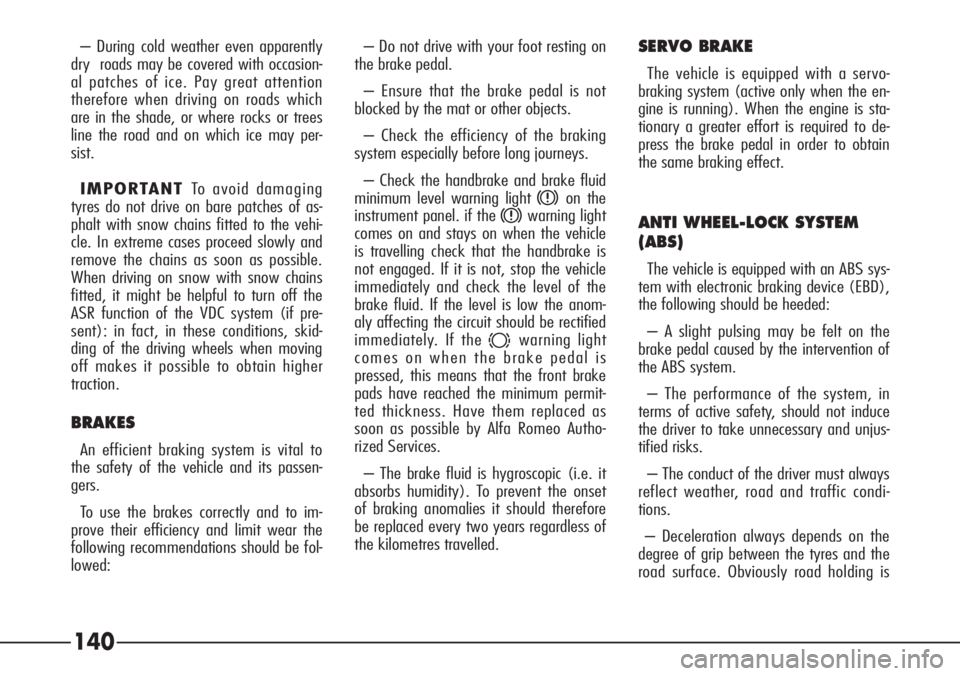
140
– During cold weather even apparently
dry roads may be covered with occasion-
al patches of ice. Pay great attention
therefore when driving on roads which
are in the shade, or where rocks or trees
line the road and on which ice may per-
sist.
IMPORTANT To avoid damaging
tyres do not drive on bare patches of as-
phalt with snow chains fitted to the vehi-
cle. In extreme cases proceed slowly and
remove the chains as soon as possible.
When driving on snow with snow chains
fitted, it might be helpful to turn off the
ASR function of the VDC system (if pre-
sent): in fact, in these conditions, skid-
ding of the driving wheels when moving
off makes it possible to obtain higher
traction.
BRAKES
An efficient braking system is vital to
the safety of the vehicle and its passen-
gers.
To use the brakes correctly and to im-
prove their efficiency and limit wear the
following recommendations should be fol-
lowed:– Do not drive with your foot resting on
the brake pedal.
– Ensure that the brake pedal is not
blocked by the mat or other objects.
– Check the efficiency of the braking
system especially before long journeys.
– Check the handbrake and brake fluid
minimum level warning light
xon the
instrument panel. if the
xwarning light
comes on and stays on when the vehicle
is travelling check that the handbrake is
not engaged. If it is not, stop the vehicle
immediately and check the level of the
brake fluid. If the level is low the anom-
aly affecting the circuit should be rectified
immediately. If the
dwarning light
comes on when the brake pedal is
pressed, this means that the front brake
pads have reached the minimum permit-
ted thickness. Have them replaced as
soon as possible by Alfa Romeo Autho-
rized Services.
– The brake fluid is hygroscopic (i.e. it
absorbs humidity). To prevent the onset
of braking anomalies it should therefore
be replaced every two years regardless of
the kilometres travelled.
SERVO BRAKE
The vehicle is equipped with a servo-
braking system (active only when the en-
gine is running). When the engine is sta-
tionary a greater effort is required to de-
press the brake pedal in order to obtain
the same braking effect.
ANTI WHEEL-LOCK SYSTEM
(ABS)
The vehicle is equipped with an ABS sys-
tem with electronic braking device (EBD),
the following should be heeded:
– A slight pulsing may be felt on the
brake pedal caused by the intervention of
the ABS system.
– The performance of the system, in
terms of active safety, should not induce
the driver to take unnecessary and unjus-
tified risks.
– The conduct of the driver must always
reflect weather, road and traffic condi-
tions.
– Deceleration always depends on the
degree of grip between the tyres and the
road surface. Obviously road holding is